Abstract
1. Three new bradykinin (BK) antagonists, D-Arg0-Hyp3-Thi5-D-Tic7-Oic8-BK (compound I), D-Arg0-Hyp3-D-Tic7-Oic8-BK (compound II), and Arg(Tos)1-Hyp3-Thi5-D-Tic7-Oic8-BK (compound III), were tested against the effects of BK in 9 bioassay preparations including visceral smooth muscles, vasoconstriction, plasma protein extravasation, release of prostaglandin E2, bronchoconstriction, and stimulation of afferent C-fibre nociceptors. In some of these tests the effects of the new compounds were compared with those of the antagonist D-Arg0-Hyp2-Thi5,8-D-Phe7-BK (compound IV), described by Stewart & Vavrek (1987). 2. For all bioassays the general rank order of potency of the compounds was found to be I greater than II greater than III much greater than IV. The new antagonists were long-acting; in some bioassays their effects outlasted the duration of the experiment. 3. The inhibitory effects of the new BK antagonists were specific for BK; actions of noradrenaline, angiotensin II, acetylcholine or histamine were unaffected by the antagonists. They did not stimulate the release of histamine or prostaglandins. An agonistic effect was observed only with very high concentrations of compounds I and II in the plasma protein extravasation test. 4. The long duration of action of the new BK antagonists is probably due to a high and long-lasting affinity to the BK receptors. A high resistance of the antagonists to enzymatic destruction may be another reason. 5. The new BK antagonists will be valuable tools for the investigation of the pathophysiological role of BK. In addition they may offer a potential for therapeutic applications.
Full text
PDF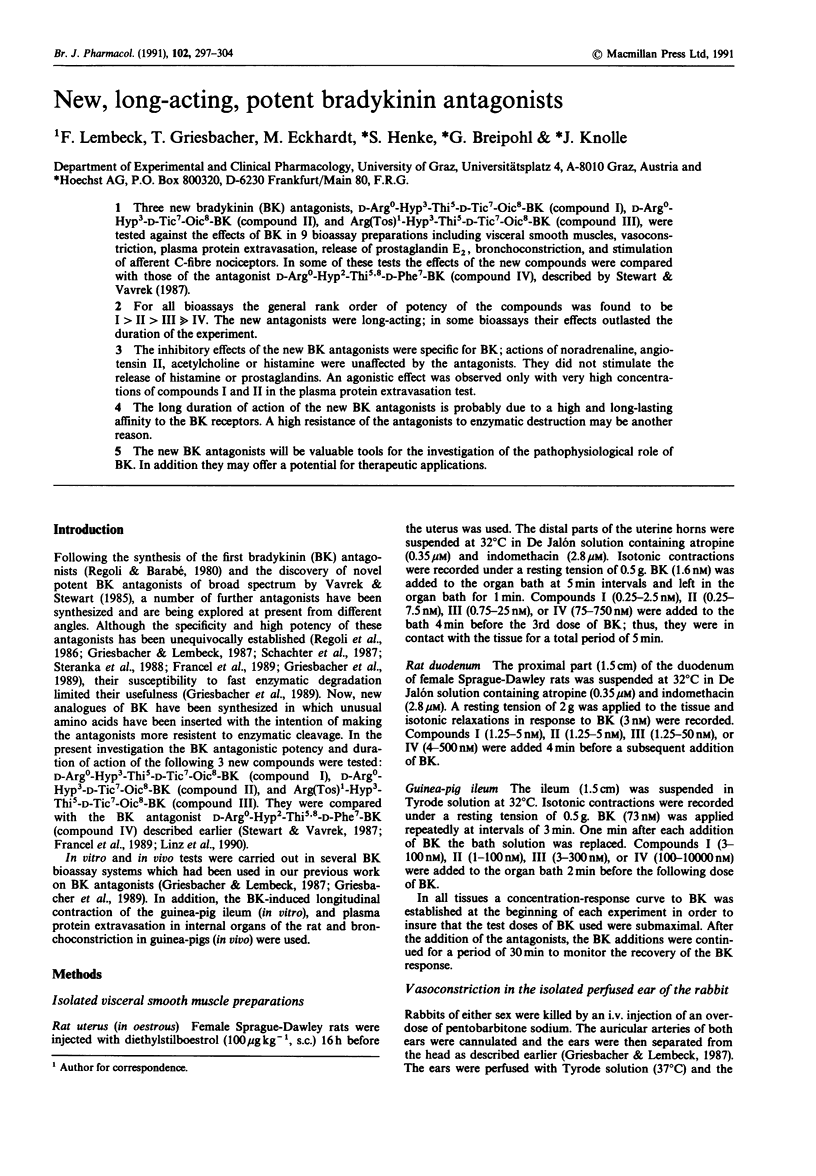
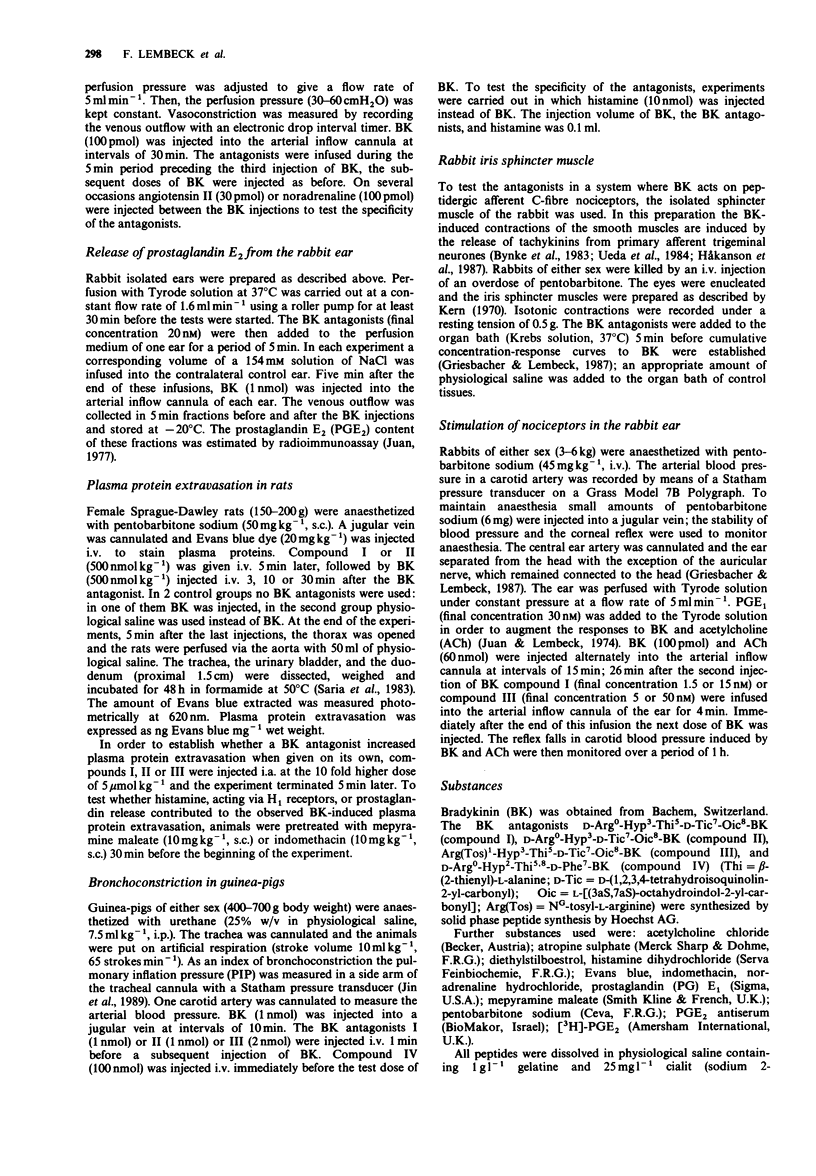
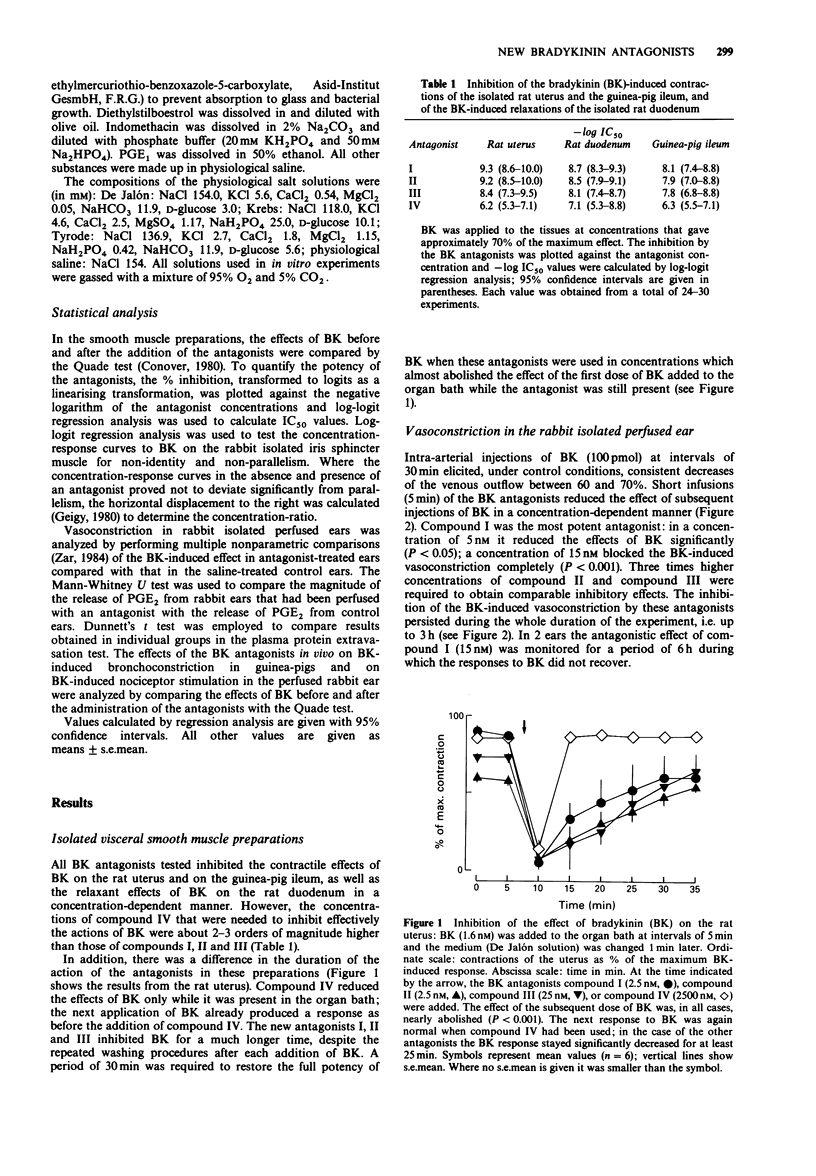

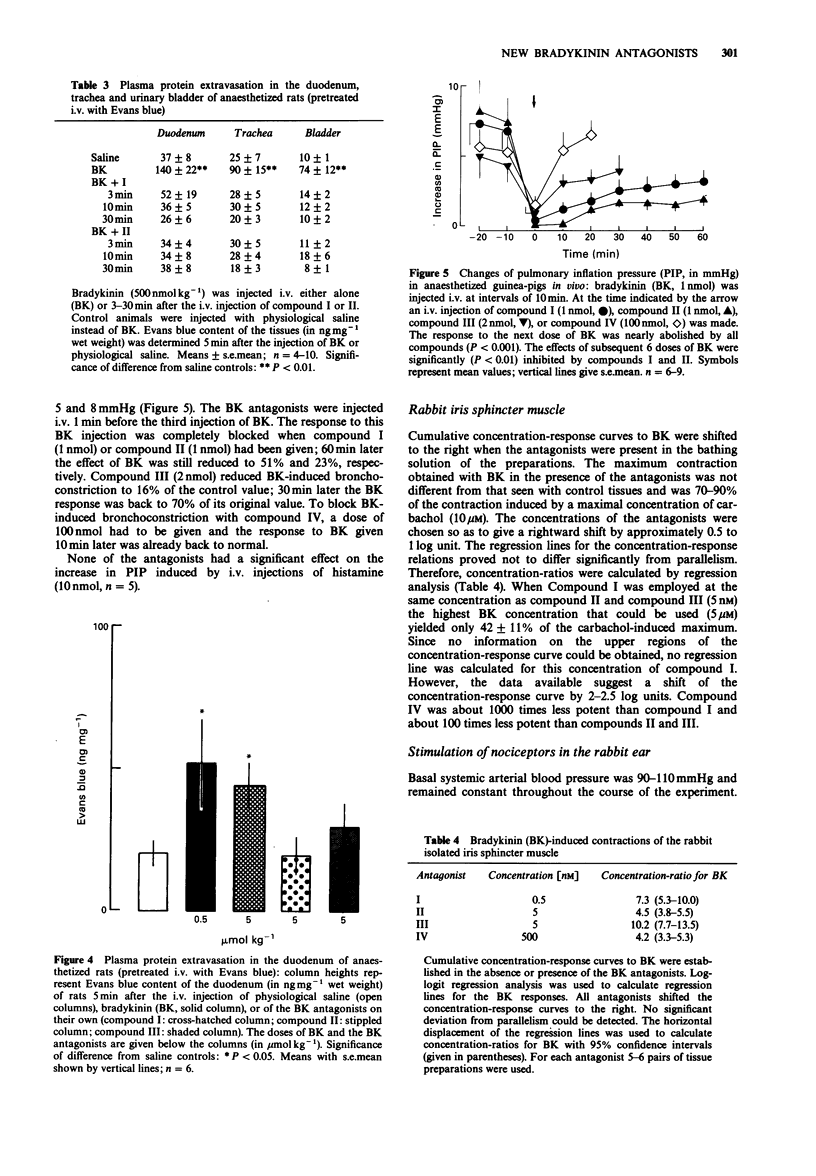
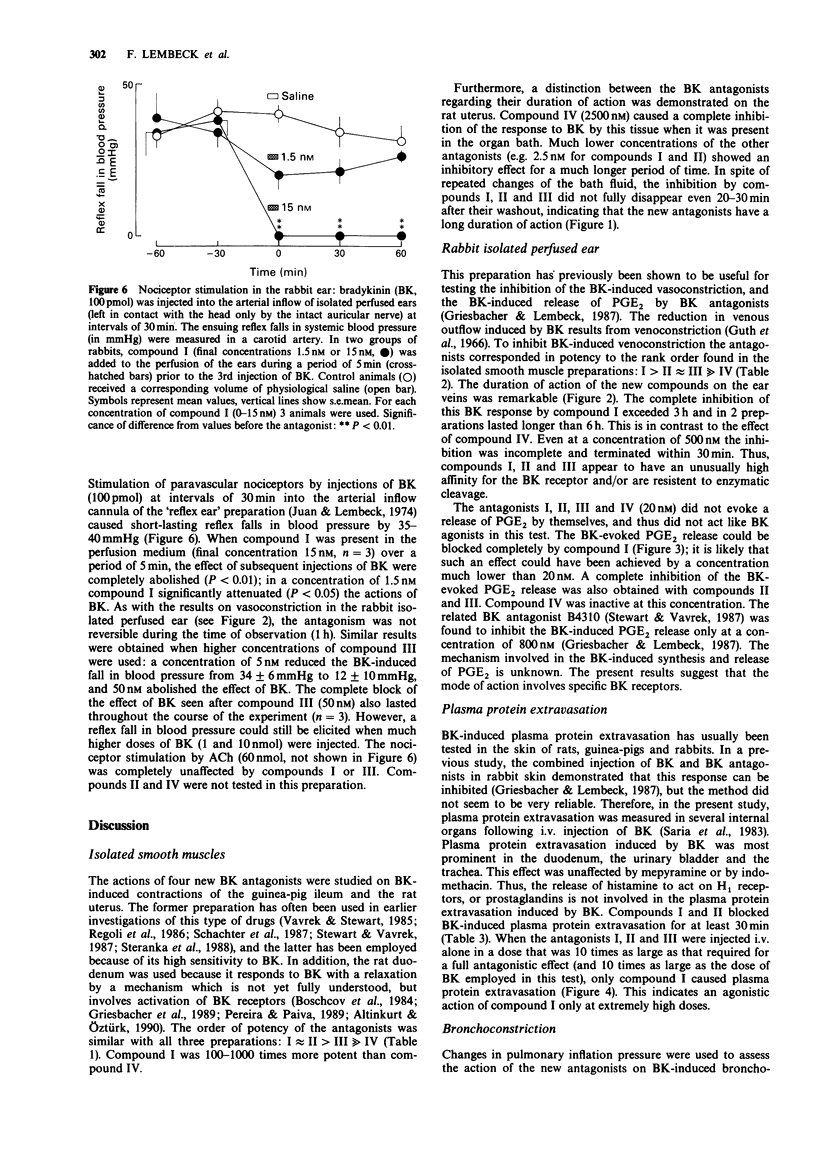
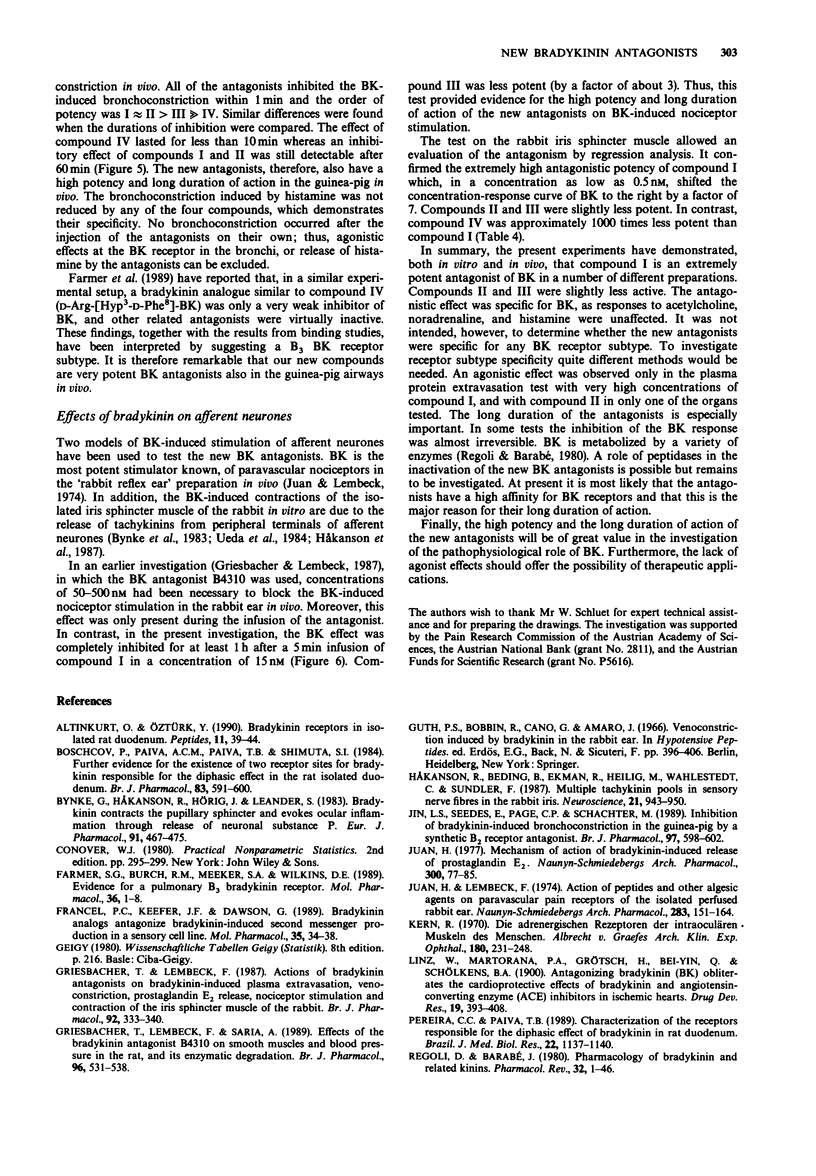
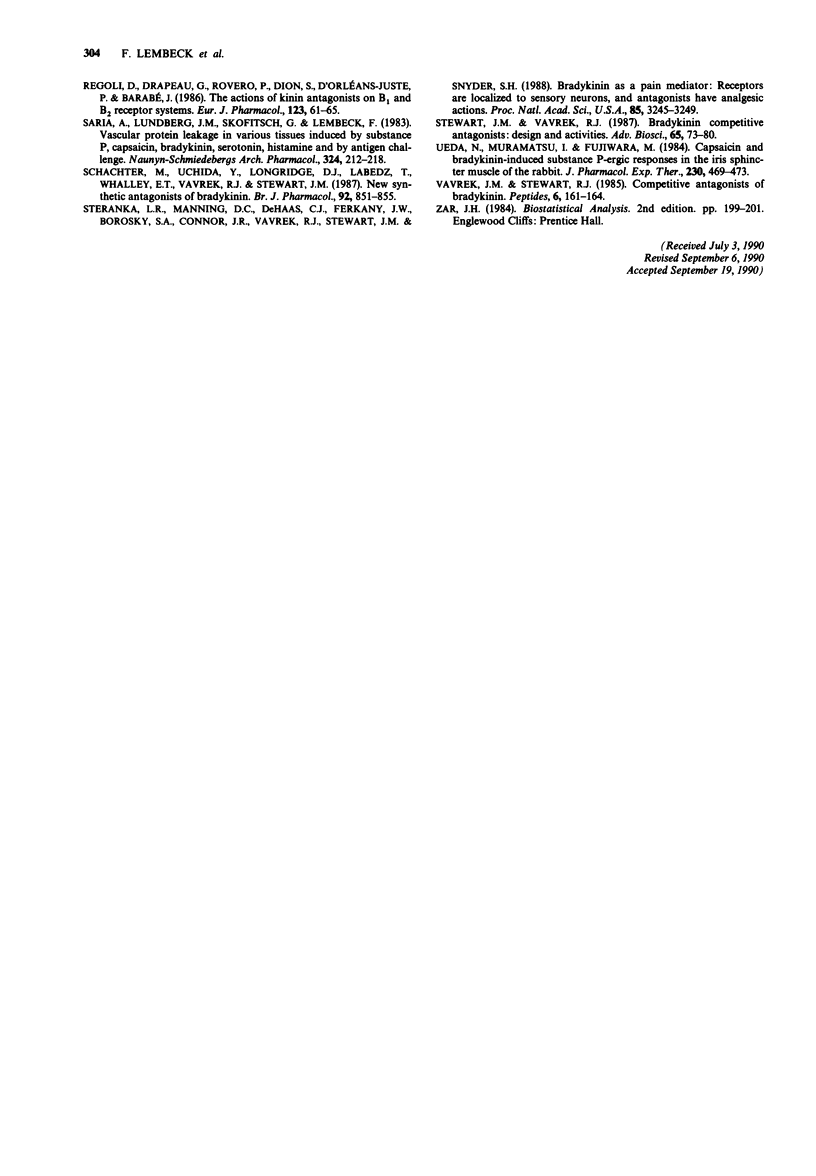
Selected References
These references are in PubMed. This may not be the complete list of references from this article.
- Altinkurt O., Oztürk Y. Bradykinin receptors in isolated rat duodenum. Peptides. 1990 Jan-Feb;11(1):39–44. doi: 10.1016/0196-9781(90)90107-g. [DOI] [PubMed] [Google Scholar]
- Boschcov P., Paiva A. C., Paiva T. B., Shimuta S. I. Further evidence for the existence of two receptor sites for bradykinin responsible for the diphasic effect in the rat isolated duodenum. Br J Pharmacol. 1984 Oct;83(2):591–600. doi: 10.1111/j.1476-5381.1984.tb16523.x. [DOI] [PMC free article] [PubMed] [Google Scholar]
- Bynke G., Håkanson R., Hörig J., Leander S. Bradykinin contracts the pupillary sphincter and evokes ocular inflammation through release of neuronal substance P. Eur J Pharmacol. 1983 Aug 5;91(4):469–475. doi: 10.1016/0014-2999(83)90172-3. [DOI] [PubMed] [Google Scholar]
- Farmer S. G., Burch R. M., Meeker S. A., Wilkins D. E. Evidence for a pulmonary B3 bradykinin receptor. Mol Pharmacol. 1989 Jul;36(1):1–8. [PubMed] [Google Scholar]
- Francel P. C., Keefer J. F., Dawson G. Bradykinin analogs antagonize bradykinin-induced second messenger production in a sensory neuron cell line. Mol Pharmacol. 1989 Jan;35(1):34–38. [PubMed] [Google Scholar]
- Griesbacher T., Lembeck F. Effect of bradykinin antagonists on bradykinin-induced plasma extravasation, venoconstriction, prostaglandin E2 release, nociceptor stimulation and contraction of the iris sphincter muscle in the rabbit. Br J Pharmacol. 1987 Oct;92(2):333–340. doi: 10.1111/j.1476-5381.1987.tb11328.x. [DOI] [PMC free article] [PubMed] [Google Scholar]
- Griesbacher T., Lembeck F., Saria A. Effects of the bradykinin antagonist B4310 on smooth muscles and blood pressure in the rat, and its enzymatic degradation. Br J Pharmacol. 1989 Mar;96(3):531–538. doi: 10.1111/j.1476-5381.1989.tb11850.x. [DOI] [PMC free article] [PubMed] [Google Scholar]
- Håkanson R., Beding B., Ekman R., Heilig M., Wahlestedt C., Sundler F. Multiple tachykinin pools in sensory nerve fibres in the rabbit iris. Neuroscience. 1987 Jun;21(3):943–950. doi: 10.1016/0306-4522(87)90049-2. [DOI] [PubMed] [Google Scholar]
- Jin L. S., Seeds E., Page C. P., Schachter M. Inhibition of bradykinin-induced bronchoconstriction in the guinea-pig by a synthetic B2 receptor antagonist. Br J Pharmacol. 1989 Jun;97(2):598–602. doi: 10.1111/j.1476-5381.1989.tb11991.x. [DOI] [PMC free article] [PubMed] [Google Scholar]
- Juan H., Lembeck F. Action of peptides and other algesic agents on paravascular pain receptors of the isolated perfused rabbit ear. Naunyn Schmiedebergs Arch Pharmacol. 1974;283(2):151–164. doi: 10.1007/BF00501142. [DOI] [PubMed] [Google Scholar]
- Juan H. Mechanism of action of bradykinin-induced release of prostaglandin E. Naunyn Schmiedebergs Arch Pharmacol. 1977 Oct;300(1):77–85. doi: 10.1007/BF00505082. [DOI] [PubMed] [Google Scholar]
- Kern R. Die adrenergischen Receptoren der intraoculären Muskeln des Menschen. Eine in vitro-Studie. Albrecht Von Graefes Arch Klin Exp Ophthalmol. 1970;180(3):231–248. doi: 10.1007/BF00411532. [DOI] [PubMed] [Google Scholar]
- Pereira C. C., Paiva T. B. Characterization of the receptors responsible for the diphasic effect of bradykinin in rat duodenum. Braz J Med Biol Res. 1989;22(9):1137–1140. [PubMed] [Google Scholar]
- Regoli D., Barabé J. Pharmacology of bradykinin and related kinins. Pharmacol Rev. 1980 Mar;32(1):1–46. [PubMed] [Google Scholar]
- Regoli D., Drapeau G., Rovero P., Dion S., D'Orléans-Juste P., Barabé J. The actions of kinin antagonists on B1 and B2 receptor systems. Eur J Pharmacol. 1986 Apr 9;123(1):61–65. doi: 10.1016/0014-2999(86)90687-4. [DOI] [PubMed] [Google Scholar]
- Saria A., Lundberg J. M., Skofitsch G., Lembeck F. Vascular protein linkage in various tissue induced by substance P, capsaicin, bradykinin, serotonin, histamine and by antigen challenge. Naunyn Schmiedebergs Arch Pharmacol. 1983 Nov;324(3):212–218. doi: 10.1007/BF00503897. [DOI] [PubMed] [Google Scholar]
- Schachter M., Uchida Y., Longridge D. J., Labedz T., Whalley E. T., Vavrek R. J., Stewart J. M. New synthetic antagonists of bradykinin. Br J Pharmacol. 1987 Dec;92(4):851–855. doi: 10.1111/j.1476-5381.1987.tb11390.x. [DOI] [PMC free article] [PubMed] [Google Scholar]
- Steranka L. R., Manning D. C., DeHaas C. J., Ferkany J. W., Borosky S. A., Connor J. R., Vavrek R. J., Stewart J. M., Snyder S. H. Bradykinin as a pain mediator: receptors are localized to sensory neurons, and antagonists have analgesic actions. Proc Natl Acad Sci U S A. 1988 May;85(9):3245–3249. doi: 10.1073/pnas.85.9.3245. [DOI] [PMC free article] [PubMed] [Google Scholar]
- Ueda N., Muramatsu I., Fujiwara M. Capsaicin and bradykinin-induced substance P-ergic responses in the iris sphincter muscle of the rabbit. J Pharmacol Exp Ther. 1984 Aug;230(2):469–473. [PubMed] [Google Scholar]
- Vavrek R. J., Stewart J. M. Competitive antagonists of bradykinin. Peptides. 1985 Mar-Apr;6(2):161–164. doi: 10.1016/0196-9781(85)90033-6. [DOI] [PubMed] [Google Scholar]


